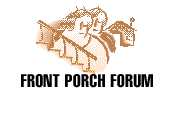Civic Journalism: Six Case Studies
SEATTLE, WASH.
“Front Porch Forum”
Washington State Trooper David Foxley, 42, is old enough to remember the days when neighbors chatted over a fence or moved easily among each other’s back yards.
Foxley, a Kiwanis Club member and co-president of the PTA at his daughter’s elementary school, missed those casual, spontaneous connections and yearned for ways to bring people together again.
Last May, Foxley found an opportunity to do something about it when he accepted an invitation to a focus group 19 miles from his home in Auburn, Washington.
The focus group was one of four held to help The Seattle Times and two public radio stations deal with a different breakdown in connections — the fraying of the links among the citizens, the news media, and the political process. The three media organizations were part of a national project, spearheaded by National Public Radio, seeking to reshape campaign coverage by giving citizens a stronger voice.
In addition to soliciting suggestions about coverage, the focus groups were designed to elicit insight into the participants’ attitudes about their lives and the issues most important to them. Those insights would provide the basis for a statewide poll; the results would guide subsequent coverage.
The energetic discussion had reached the closing coffee-and-cookies stage when Foxley inadvertently linked his own concerns to those of the journalists when he suggested “a front-porch forum, an open forum, where people would go and talk, and people would listen.”
The trooper’s wistful description reminded the local journalists watching behind a two-way mirror that listening and responding to the public was at the heart of their project. And they adopted the name, “Front Porch Forum.”

Between the focus groups in May and the election in November, the Times and public radio stations KPLU-FM at Pacific Lutheran University in Tacoma and KUOW-FM at the University of Washington in Seattle built a virtual front porch where residents could talk to candidates and to one another.
They used call-in shows, question-and-answer columns, roundtable discussions, and even an unusual candidate debate with five undecided voters as the panel. Their expanded coverage of citizen-identified issues — crime, education, growth, health care — gave people plenty to talk about.
The partners had mutual objectives:
- To create a climate in which citizens — not politicians and the media — set the agenda for campaigns and public debate.
- To involve readers and listeners more directly than ever before.
- To produce insightful and engaging journalism.
Along the way, the Times discovered the value of melding previously used techniques such as focus groups, citizens’ panels, and issues polling into a cohesive package pulled together by a single theme. KPLU and KUOW gained access to a larger audience for the most significant public service project in either station’s history. And all three discovered the promotional value of the campaign, using it to reach new audiences while showing readers and listeners they were serious about change.
There were pitfalls, too. The partners failed to bring television into the alliance, thereby losing some leverage with candidates and a chance to reach an even larger audience. The attempts to have candidates answer questions was not always effective. And, despite all the efforts to discern the citizens’ mood, the partners failed to gauge the full extent of the anger many took to the polls.
![]()
Forging New Connections
Changing campaign coverage meant changing some traditional newsroom views about issues, citizens, competitors, and what was news.
To begin, the radio competitors had to form an alliance. KPLU, the public radio ratings leader, offered a mixture of NPR programming, jazz, and local coverage; KUOW switched from classical music to news and information in 1993. Both stations broadcast several NPR programs, including Morning Edition and All Things Considered, but KUOW was the only one that carried Talk of the Nation.
Staffers at each station first heard about the election project in the summer of 1993. Eager to take part, KPLU news director Michael Marcotte and KUOW news director Marcie Stillman literally signed a truce, pledging to work together to deliver “maximum impact.” Separate proposals, they feared, might cancel out each other or provide a less attractive incentive for National Public Radio, funded by the Pew Charitable Trusts, to select either of them as a participant in its national project with The Poynter Institute for Media Studies.
